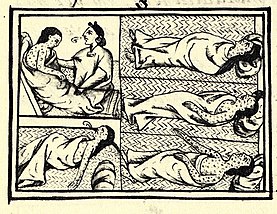
In epidemiology, a virgin soil epidemic is an epidemic in which populations that previously were in isolation from a pathogen are immunologically unprepared upon contact with the novel pathogen.[1] Virgin soil epidemics have occurred with European colonization, particularly when European explorers and colonists brought diseases to lands they conquered in the Americas, Australia and Pacific Islands.[2]
When a population has been isolated from a particular pathogen without any contact, individuals in that population have not built up any immunity to that organism and also have not received immunity passed from mother to child.[3] The epidemiologist Francis Black has suggested that some isolated populations may not have mixed enough to become as genetically heterogeneous as their colonizers, which would also have affected their natural immunity, due to the potential benefits to immune system function due to genetic diversity.[3] That can happen also when such a considerable amount of time has passed between disease outbreaks that no one in a particular community has ever experienced the disease to gain immunity.[4] Consequently, when a previously unknown disease is introduced to such a population, there is an increase in the morbidity and mortality rates. Historically, that increase has been often devastating and always noticeable.[2]
Diseases introduced to the Americas by Europeans and Africans include smallpox, yellow fever, measles and malaria as well as new strains of typhus and influenza.[5][6]
Virgin soil epidemics also occurred in other regions. For example, the Roman Empire spread smallpox to new populations in Europe and the Middle East in the 2nd century AD, and the Mongol Empire brought the bubonic plague to Europe and the Middle East in the 14th century.[6]

- ^ Crosby, Alfred W. (1976). "Virgin Soil Epidemics as a Factor in the Aboriginal Depopulation in America". The William and Mary Quarterly. 33 (2): 289–299. doi:10.2307/1922166. ISSN 0043-5597. JSTOR 1922166. PMID 11633588.
- ^ a b Cite error: The named reference
Cliff120was invoked but never defined (see the help page). - ^ a b Cite error: The named reference
Hays87was invoked but never defined (see the help page). - ^ Daschuk, James (2013). Clearing the Plains: Disease, Politics of Starvation and the Loss of Aboriginal Life. Regina: University of Regina Press. pp. 11–12. ISBN 9780889772960.
- ^ Cite error: The named reference
Crosby1976was invoked but never defined (see the help page). - ^ a b Cite error: The named reference
Alchon80was invoked but never defined (see the help page).
© MMXXIII Rich X Search. We shall prevail. All rights reserved. Rich X Search
